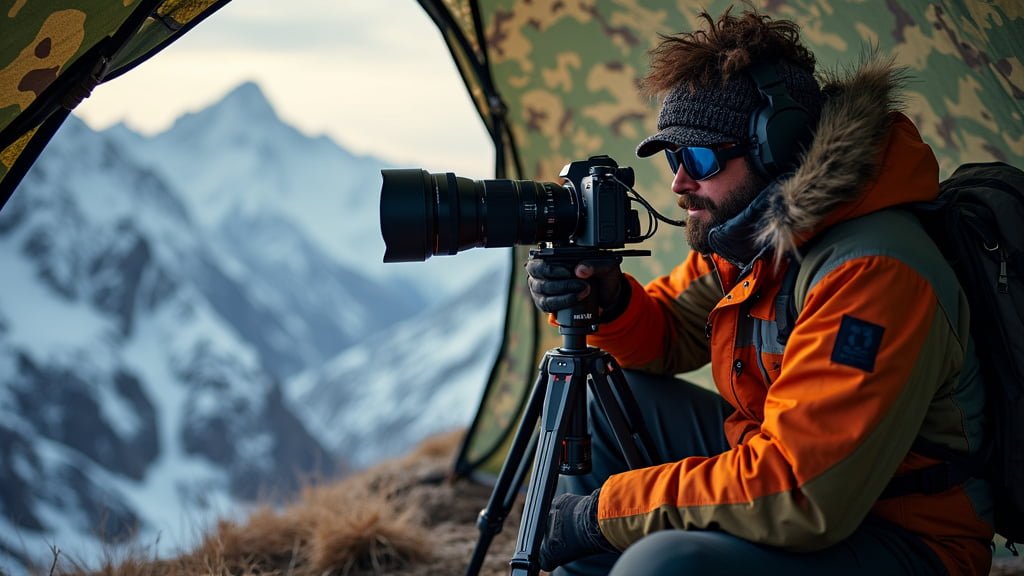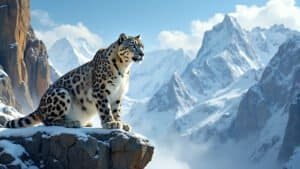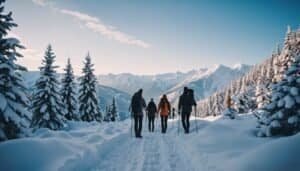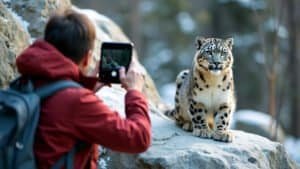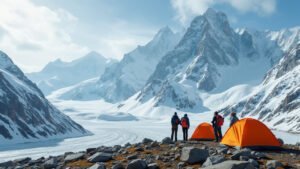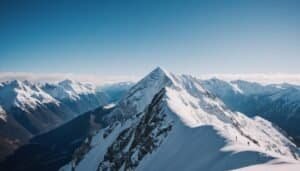Introduction
Embarking on a snow leopard photography expedition requires meticulous preparation to capture the elusive and majestic big cat in its rugged, high-altitude habitat
In this article, we’ll cover everything you need, from choosing the right camera gear and cold-weather clothing to understanding the best locations for spotting snow leopards. You’ll also learn essential safety tips for operating in harsh environments and how to ethically photograph snow leopards without disturbing their natural behavior
Whether you’re a seasoned wildlife photographer or a beginner, these tips will help you prepare for a successful and responsible snow leopard photography expedition
Essential Gear for Snow Leopard Photography
Preparing for a snow leopard photography expedition starts with gathering the right gear to ensure you’re equipped for both the harsh environment and the unique challenges of wildlife photography
Since snow leopards live in remote, cold, and mountainous regions, your equipment must be durable, weatherproof, and capable of capturing high-quality images even in low light
Here, we’ll break down the essential gear needed for a successful expedition, including camera choices, cold-weather clothing, and useful accessories
Choosing the Right Camera and Lenses
When it comes to photographing snow leopards, a high-quality camera with advanced features is crucial. Since these elusive cats are typically spotted from a distance, a DSLR or mirrorless camera with a fast autofocus system and a high frame rate is ideal
Cameras such as the Canon EOS R5 or Nikon Z9, which offer excellent image resolution and fast burst shooting, are often recommended for wildlife photography
For lenses, telephoto options are a must. Snow leopards tend to blend into their environment, and spotting them from afar is common. A lens with a focal length of at least 400mm, like the Canon EF 400mm f/4 or the Nikon 200-500mm f/5.6, ensures you can zoom in without getting too close and disturbing the animal
A lens with image stabilization is particularly important, given that you may have to shoot handheld in rugged conditions. Additionally, carrying a wide-angle lens can be useful for capturing the dramatic landscapes of snow leopard habitats, providing context to your wildlife shots
Cold-Weather Clothing and Equipment
In the high-altitude ranges where snow leopards reside, temperatures can drop to extreme lows. To protect yourself from these conditions, you’ll need high-performance cold-weather gear
Layering is essential for maintaining warmth while allowing flexibility. Start with moisture-wicking base layers, followed by an insulating mid-layer such as a down jacket, and a waterproof, windproof outer shell to protect against snow and wind
Footwear is equally critical. Insulated, waterproof boots with strong ankle support are necessary for hiking through snow and rough terrain. Brands like Salomon or La Sportiva are known for producing boots that are durable and designed for such conditions. Don’t forget accessories like gloves, thermal hats, and neck gaiters. It’s essential to also protect your camera gear from the cold
Specialized camera gloves, like those from Vallerret, allow for easy use of your camera’s buttons while keeping your hands warm. Carrying insulated camera covers and lens hoods helps prevent frost buildup and condensation
Accessories for Wildlife Photography
In addition to your camera and cold-weather gear, several accessories can greatly enhance your snow leopard photography experience
A sturdy, lightweight tripod is essential for stable shots, especially when using long telephoto lenses. Carbon fiber tripods, like those made by Gitzo, offer stability while being light enough to carry on long treks. A remote shutter release can be useful for reducing camera shake when using slower shutter speeds in low light
Spare batteries and memory cards are a must for any wildlife photography expedition. Cold temperatures drain battery life faster, so carrying multiple fully charged batteries will ensure you don’t miss any shots
Likewise, high-capacity memory cards, preferably fast ones like UHS-II, allow you to take numerous high-resolution images and videos without needing frequent changes
Other useful items include a rangefinder or binoculars for scouting distant wildlife, and a portable solar charger for keeping electronics powered during extended stays in remote areas
Having a reliable backpack, such as those from Lowepro or F-Stop, designed to hold both your camera gear and personal items, will ensure your gear remains organized and protected while hiking through challenging terrain
Finding the Right Location for Snow Leopard Photography
Selecting the ideal location for snow leopard photography is crucial for increasing your chances of spotting and capturing these elusive animals. Snow leopards inhabit some of the most remote and rugged regions of the world, primarily across the mountain ranges of Central Asia
In this section, we will explore the best regions for snow leopard sightings, the importance of working with local guides, and how understanding the species’ habitat can help improve your photography outcomes
Top Regions for Snow Leopards in the Wild
Snow leopards are distributed across 12 countries, but certain regions have higher populations and better accessibility for photographers
Among the most prominent areas are the Himalayas in India and Nepal, the Altai Mountains of Russia and Mongolia, and the Tian Shan range of Kyrgyzstan and Kazakhstan
The Hemis National Park in Ladakh, India, is one of the most renowned destinations for snow leopard photography. This area offers relatively high chances of sightings during the winter months, when snow leopards descend from higher altitudes in search of prey
Hemis is not only home to a healthy population of snow leopards, but it also has an established infrastructure for tourism and wildlife expeditions, making it one of the most accessible regions for photographers
In addition to Ladakh, the remote Spiti Valley in India and the Annapurna Conservation Area in Nepal are also prime locations. Both areas provide rich landscapes and snow leopard habitats, with organized eco-tourism initiatives aimed at supporting both local communities and wildlife conservation efforts
Mongolia’s South Gobi region and Russia’s Altai Mountains are more remote but offer breathtaking, untouched landscapes, providing a rewarding challenge for experienced photographers
Working with Local Guides and Trackers
Snow leopards are notoriously difficult to spot, even in areas where they are known to live. Working with experienced local guides or wildlife trackers significantly increases the likelihood of a successful expedition
These guides often have intimate knowledge of the landscape and the snow leopards’ behavior, including where they tend to roam, their prey patterns, and specific signs of recent activity, such as tracks or scratch marks on rocks
Local guides are also invaluable for navigating the rough terrain. Their expertise can help you avoid potential hazards, conserve energy, and stay focused on photography rather than survival
Many guides also assist with setting up camera traps or finding the right vantage points for long waits, which is often the nature of snow leopard photography
Besides aiding in tracking the elusive cats, hiring local guides supports the local economy and promotes sustainable tourism. Eco-tourism programs in places like Ladakh are centered around preserving snow leopard habitats and reducing human-wildlife conflict, often with local villagers acting as both conservationists and expert trackers
Importance of Understanding Snow Leopard Habitats
Snow leopards typically reside in high-altitude areas, between 9,800 and 16,500 feet (3,000 to 5,000 meters), characterized by rocky cliffs, steep terrain, and sparse vegetation. They prefer these isolated and hard-to-reach environments because it offers both cover for stalking prey and protection from human interference
Understanding their habitat is essential to being in the right place at the right time. For instance, snow leopards rely on specific prey such as blue sheep (bharal), ibex, and marmots, and their movement patterns are often dictated by the location of these prey animals
During the winter months, snow leopards follow their prey to lower elevations, which increases the likelihood of sightings. Conversely, during the summer, they move higher up the mountains, making them even harder to locate
When planning your expedition, studying maps of known snow leopard ranges and reviewing recent wildlife sighting reports can help you narrow down prime locations
Additionally, timing your trip with prey migration seasons or colder months can dramatically improve your chances of encountering a snow leopard in its natural environment
Safety and Ethical Considerations in Snow Leopard Photography
Photographing snow leopards in their natural habitat presents not only technical and logistical challenges but also safety and ethical concerns
Snow leopards reside in extreme environments where harsh weather, difficult terrain, and high altitudes pose significant risks to photographers. Moreover, ensuring that the animals are not disturbed or harmed in the process of capturing images is critical for ethical wildlife photography
This section will cover essential safety precautions for working in snow leopard habitats and the ethical guidelines to follow to minimize human impact on these elusive creatures
Staying Safe in High-Altitude Environments
The high-altitude regions where snow leopards live, often exceeding 10,000 feet, require photographers to be physically prepared for the challenges of thin air, cold temperatures, and rugged terrain
Altitude sickness is a real risk, especially if you ascend too quickly without acclimatizing. Symptoms can include headaches, dizziness, nausea, and shortness of breath, all of which can hinder your ability to focus on photography
To reduce the risk of altitude sickness, it’s essential to spend several days acclimatizing at a moderate elevation before reaching higher ground
Gradually ascending and staying hydrated are crucial strategies for coping with the reduced oxygen levels. Photographers should also be familiar with the signs of altitude sickness and have a plan to descend immediately if symptoms worsen
Cold temperatures present another safety challenge. Frostbite, hypothermia, and cold-related injuries are concerns in snow leopard habitats, where temperatures often drop below freezing, especially at night
To avoid these dangers, dressing in layers and using insulated gear, as mentioned earlier, is key. Having a reliable communication device, such as a satellite phone, and emergency supplies, including a first aid kit, is critical for staying safe in these remote areas, where help may be hours or days away
Ethical Wildlife Photography Practices
Photographing snow leopards ethically is essential to preserving both the species and its habitat. Snow leopards are classified as “vulnerable” on the IUCN Red List due to threats such as habitat loss, poaching, and human-wildlife conflict
Ethical photographers must prioritize the well-being of the animal over the desire for the perfect shot
One fundamental principle of ethical wildlife photography is maintaining a respectful distance from the animal. Getting too close can stress the snow leopard, alter its behavior, and potentially drive it away from crucial hunting or mating grounds
Using long telephoto lenses, as recommended, allows photographers to capture detailed images without encroaching on the animal’s space
Additionally, it’s essential to avoid baiting or manipulating the environment to lure a snow leopard into view. This practice not only disturbs the natural behavior of the animal but can also create dangerous situations for both the wildlife and humans. For example, baiting can encourage animals to associate humans with food, increasing the likelihood of future conflict
Photographers should also minimize noise and movement in snow leopard habitats. Using natural cover and remaining patient and quiet while waiting for a snow leopard to appear reduces the chances of scaring the animal away
Many professional wildlife photographers adhere to the guidelines set forth by the International League of Conservation Photographers (iLCP), which emphasize responsible and ethical practices in wildlife photography
Minimizing Your Impact on Snow Leopards and Their Habitat
When venturing into remote snow leopard habitats, it is crucial to leave no trace. The landscapes where snow leopards live are fragile ecosystems, and human presence can have lasting effects if not managed properly
Always pack out all waste, including biodegradable items, as food scraps can attract other wildlife and disrupt the local food chain
Limiting your group size can also reduce your impact on the environment. Large groups can cause more noise and leave behind more footprints, increasing the risk of disturbing wildlife
Many expeditions to snow leopard regions, particularly in protected areas like Ladakh’s Hemis National Park, operate under strict eco-tourism guidelines, which ensure that visitors minimize their environmental footprint
Supporting conservation efforts through your photography is another way to ethically engage with wildlife. Many photographers collaborate with conservation organizations to raise awareness about the plight of snow leopards. By sharing your images responsibly and advocating for wildlife protection, you can contribute to preserving these magnificent animals for future generations
Techniques for Capturing Snow Leopards in the Wild
Photographing snow leopards requires a combination of patience, knowledge of the animal’s behavior, and mastery of specific wildlife photography techniques. Due to the elusive nature of snow leopards, which are camouflaged against rocky landscapes and often active at dawn or dusk, capturing a high-quality image can be challenging
This section will explore the techniques that can improve your chances of success, from using the right camera settings to deploying camera traps for remote photography
Patience and Observation in Wildlife Photography
One of the most critical elements in snow leopard photography is patience. Snow leopards are solitary animals and can remain hidden for days or weeks, blending into their rocky environment. Photographers often spend long hours, or even days, in the same location, waiting for the perfect opportunity
To maximize your chances, it’s essential to work closely with local guides who have expertise in tracking these animals and can predict their movement based on weather conditions, prey availability, and past sightings
Positioning yourself at a strategic vantage point is key to both observing and photographing snow leopards. These animals typically patrol large territories, often traversing cliffs and ridgelines
Setting up your equipment near well-known paths or near areas frequented by prey can improve your chances of a sighting. Make sure to blend into your surroundings by wearing muted or earth-tone colors that don’t stand out in the snowy landscape
Observation is just as important as patience. Knowing how to read the landscape for signs of recent snow leopard activity can help you anticipate where the animal might appear. Look for tracks, scratch marks on rocks, or scat that can indicate a nearby snow leopard
Observing the behavior of prey animals like ibex or blue sheep can also offer clues, as their heightened alertness can signal a predator in the area
Using Camera Traps for Remote Shots
Given the difficulty of spotting snow leopards in person, many wildlife photographers use camera traps to capture these elusive animals remotely
Camera traps are motion-activated cameras placed in the environment, allowing you to capture images of wildlife without being physically present. They are particularly useful for capturing nocturnal or shy animals like snow leopards that may be difficult to observe directly
When setting up a camera trap, it’s crucial to place it along known wildlife corridors or near water sources that snow leopards frequent. You can also position the traps near cliffs or rocky outcrops where snow leopards mark their territory
To avoid scaring the animals, it’s important to camouflage the camera and ensure that it doesn’t emit noise or light that could startle the leopard
Most camera traps, such as those made by Bushnell or Reconyx, come equipped with infrared sensors and flash systems that operate discreetly in low light. They also allow for time-lapse settings, enabling you to monitor an area over a prolonged period
This technique has been widely used in snow leopard research to monitor populations and behaviors. A study published by WWF (2020) demonstrated that camera traps are highly effective for both scientific research and photography in remote and rugged habitats where direct observation is limited
Camera Settings for Low-Light and Camouflage Conditions
Capturing snow leopards often requires working in challenging light conditions. These animals are most active during the early morning or late afternoon, when the light is dim. To ensure you get sharp, well-exposed images, it’s important to adjust your camera settings accordingly
First, using a fast shutter speed is essential to freeze the movement of a snow leopard, especially if it’s walking or running across rocky terrain. A shutter speed of at least 1/1000th of a second is recommended for wildlife photography, though this may vary depending on the level of light
Increasing the ISO sensitivity can help compensate for the low-light conditions, but be mindful of noise, which can reduce image quality. Modern cameras like the Sony A7R V or the Nikon Z9 handle higher ISO settings well, allowing you to push the sensitivity to 3200 or higher without significant noise
For aperture, a wider setting (f/4 or f/5.6) can help to let in more light and create a shallow depth of field, making the snow leopard stand out against its background. However, if you’re trying to capture both the snow leopard and the landscape, stopping down to f/8 or f/11 will ensure more of the scene remains in focus
Using continuous autofocus is another critical setting. Snow leopards can move quickly through rugged terrain, and tracking their movement with single-shot autofocus may result in blurry images
Most wildlife photographers set their cameras to continuous autofocus mode (AI-Servo on Canon or AF-C on Nikon/Sony), which allows the camera to keep the subject in focus even as it moves across the frame
Finally, using burst mode will enable you to take multiple shots in quick succession, increasing your chances of capturing the perfect moment
Wildlife photography is unpredictable, and snow leopards are often in motion, so having the ability to capture a series of images in a split second can make all the difference
Conclusion
A successful snow leopard photography expedition requires thorough preparation and a deep understanding of both the environment and the animal itself
From selecting the right camera gear, such as telephoto lenses and cold-weather equipment, to carefully choosing the best locations like Ladakh and the Altai Mountains, each decision impacts your chances of capturing these elusive creatures
Safety is paramount when operating in high-altitude, extreme climates, and ethical considerations should guide every step to minimize disturbance to the snow leopard and its habitat
Employing techniques such as using camera traps and mastering low-light photography can further enhance your ability to capture stunning images of these rare animals. With the right preparation, patience, and respect for nature, photographers can not only succeed in photographing snow leopards but also contribute to their conservation
